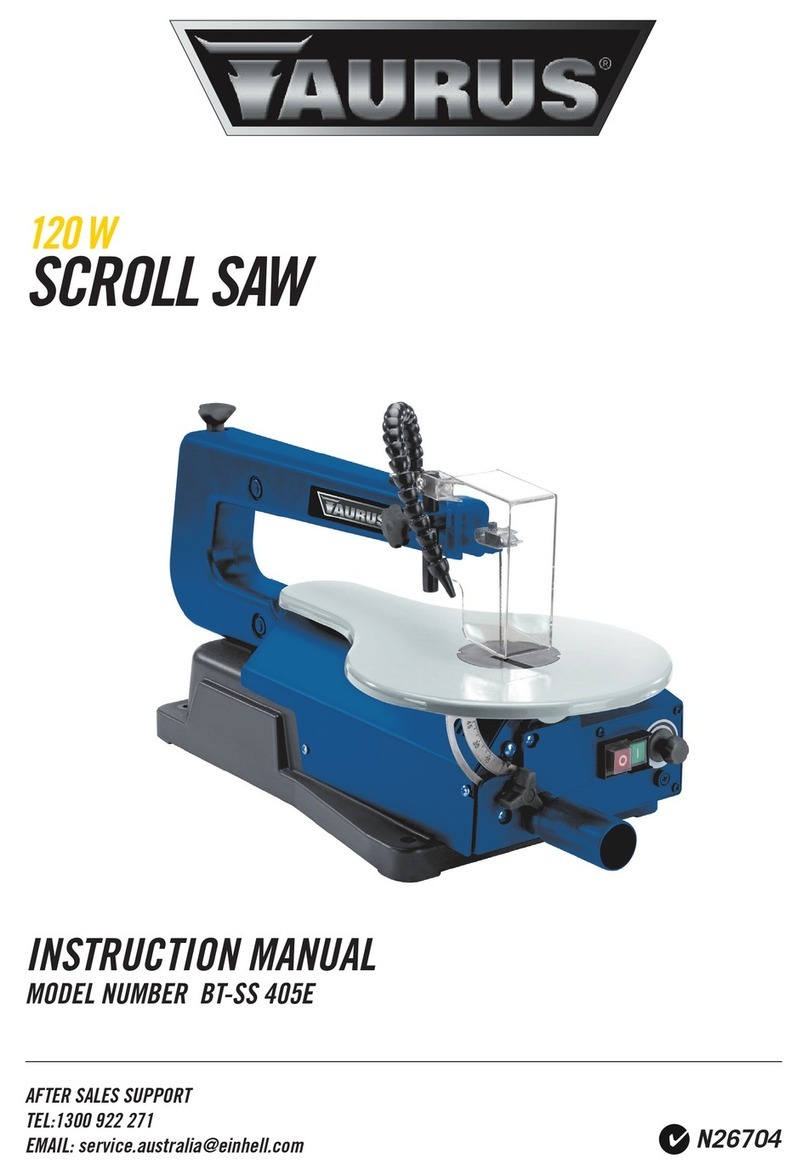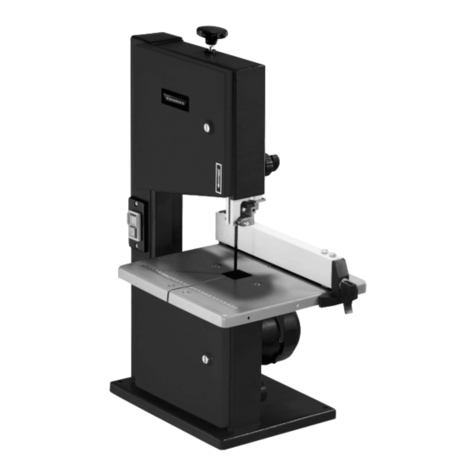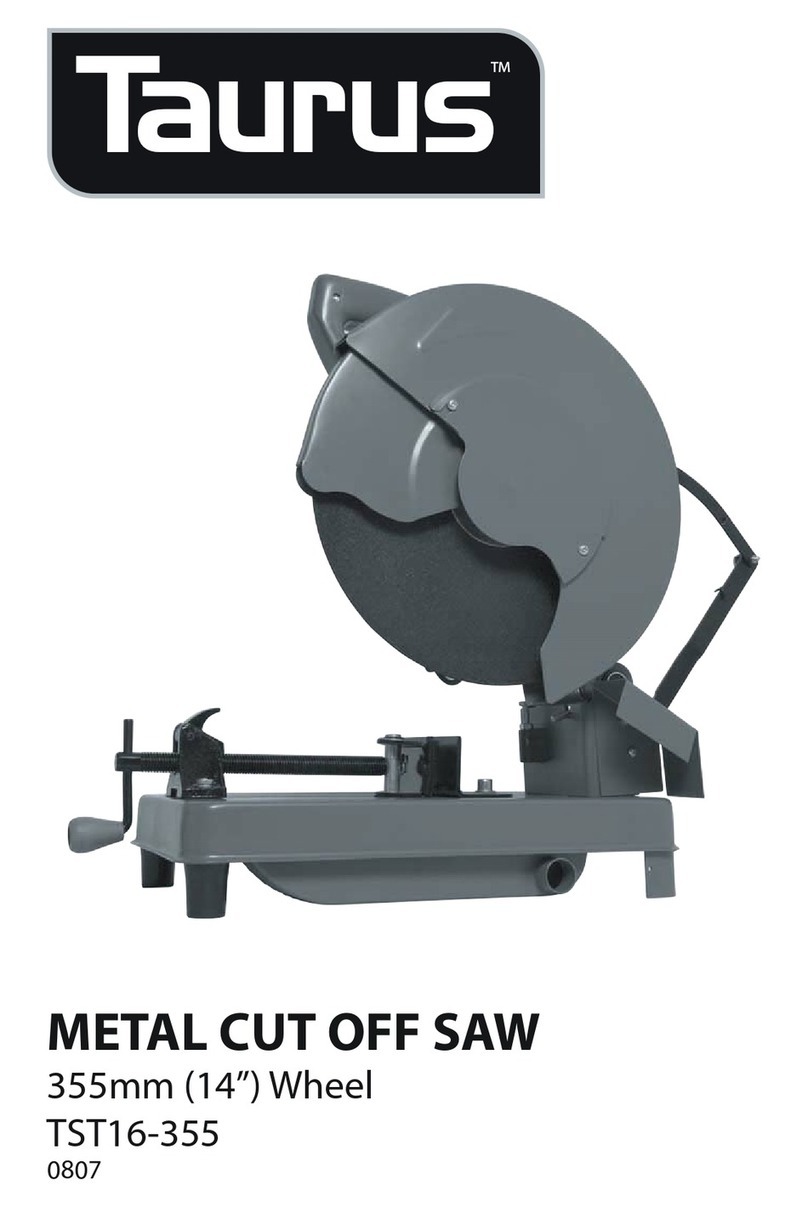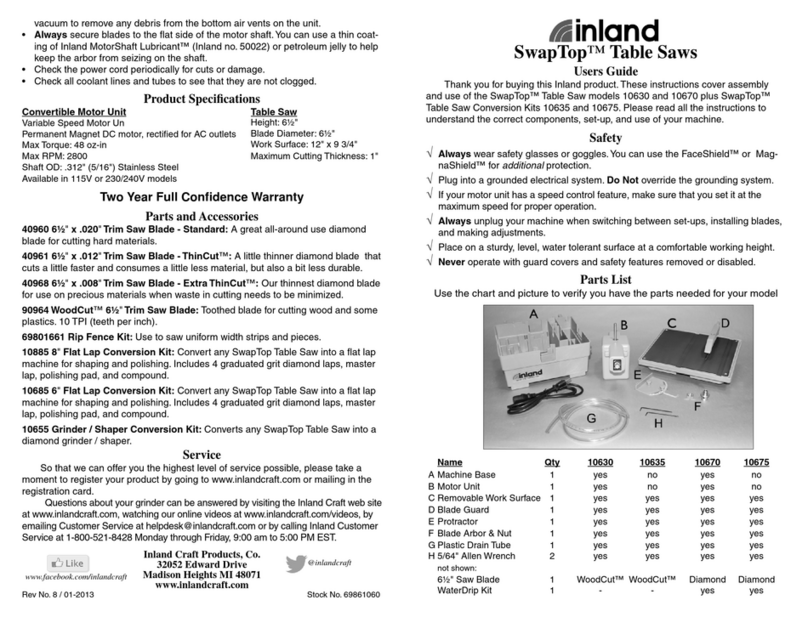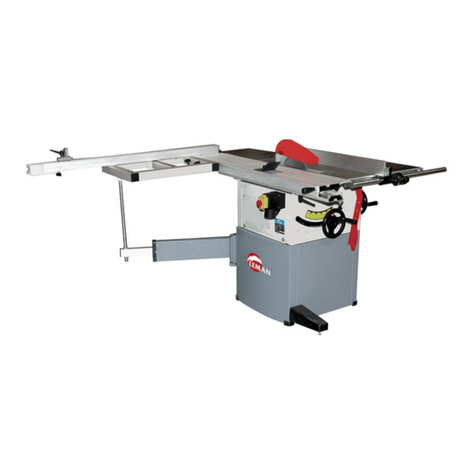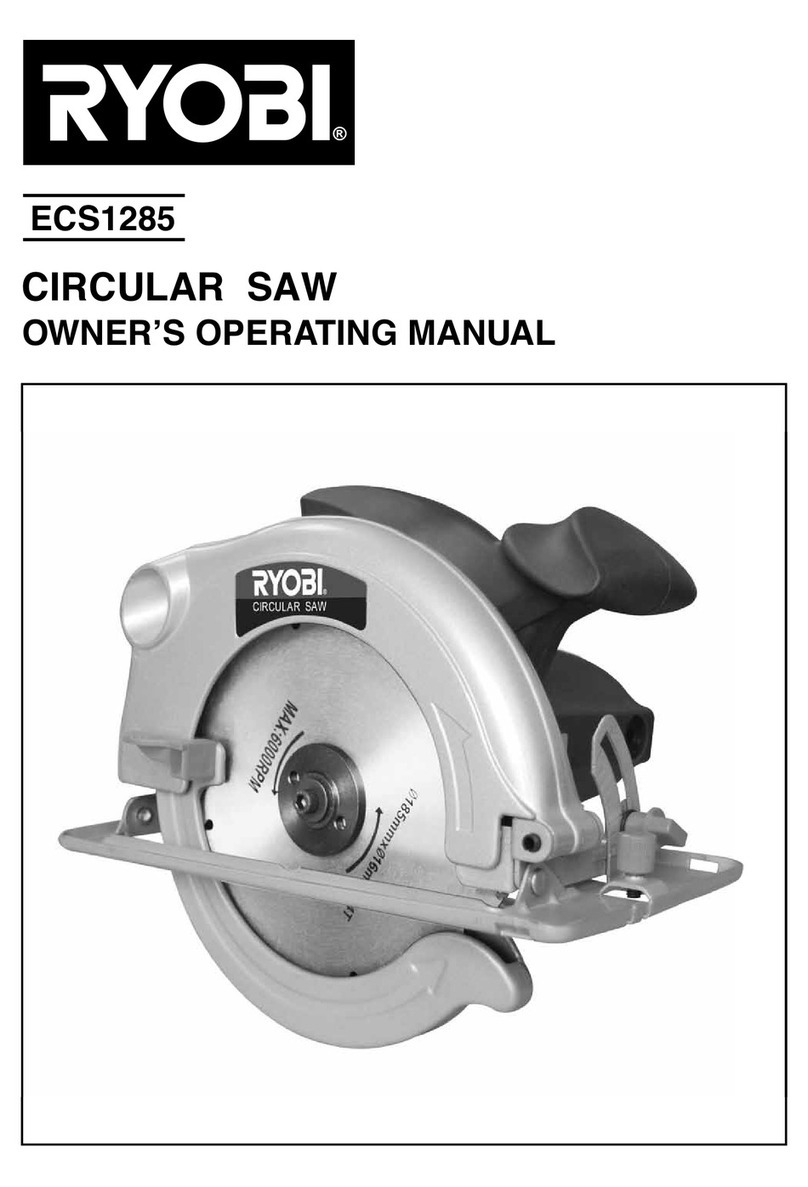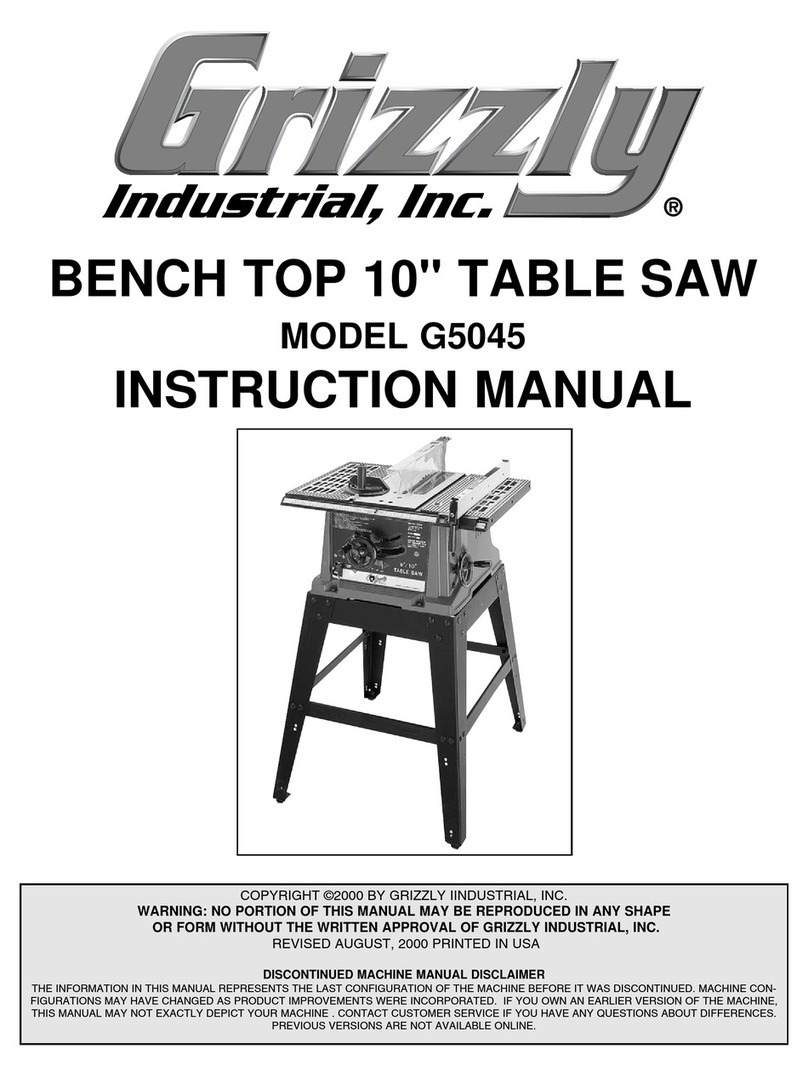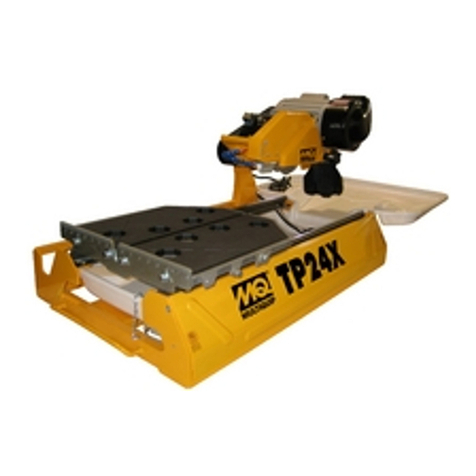Taurus Titanium BT-SM 2534 DUAL User manual

2200W
SLIDING MITRE SAW
N26704
INSTRUCTION MANUAL
AFTER SALES SUPPORT
TEL: 1300 922 271
EMAIL: [email protected]
MODEL NUMBER BT-SM 2534 DUAL

Sliding Mitre Saw
What your 3year warranty means
Great care has gone into the manufacture of this product and it should therefore provide you with years
of good service when used properly. In the event of product failure within its intended use over the course
of the rst 3 years after the date of purchase, we will remedy the problem as quickly as possible once it has
been brought to our attention. In the unlikely event of such an occurrence, or if you require any information
about the product, please contact us via our after sales support services, details of which can be found
in this manual and on the product itself.
Welcome Section
Congratulations on choosing to buy a TAURUS TITANIUM® product.
All products brought to you by TAURUS TITANIUM® are manufactured to the highest standards
of performance and safety, and, as part of our philosophy of customer service and satisfaction, are backed
by our comprehensive 3Year Warranty.
We hope you will enjoy using your purchase for many years to come.
Table of Contents
1. General Safety Rules 08
2. Special Safety Rules 09
3. Layout 11
4. Items Supplied 12
5. Intended Use 12
6. Technical Data 12
7. Before Starting the Equipment 13
8. Functions 14
9. Replacing the Power Cable 15
10. Cleaning, Maintenance & Ordering of Spare Parts 16
11. Storage 16
12. Disposal & Recycling 16
AFTER SALES SUPPORT

22 1
10
8
20
35
19
6
7
18
14
911 10
21
6
7
28
5
12 13
16
15
17
13
26
21 33 14
26
36 2434 27 25
23
12
24
z
3
108
d
c
37
33
22 1
10
8
20
35
19
6
7
18
14
911 10
21
6
7
28
5
12 13
16
15
17
13
26
21 33 14
26
36 2434 27 25
23
12
24
z
3
108
d
c
37
33
1
22 1
10
8
20
35
19
6
7
18
14
911 10
21
6
7
28
5
12 13
16
15
17
13
26
21 33 14
26
36 2434 27 25
23
12
24
z
3
108
d
c
37
33
2 3
AFTER SALES SUPPORT
MODEL NUMBER: BT-SM 2534 DUAL, 12/11

AFTER SALES SUPPORT
10
26
10
30
19
21
20
29
26
21 30
19
a 7
20
8
18
17
10
26
10
30
19
21
20
29
26
21 30
19
a 7
20
8
18
17
4 5
10
26
10
30
19
21
20
29
26
21 30
19
a 7
20
8
18
17
10
26
10
30
19
21
20
29
26
21 30
19
a 7
20
8
18
17
6 7a
10
26
10
30
19
21
20
29
26
21 30
19
a 7
20
8
18
17
10
26
10
30
19
21
20
29
26
21 30
19
a 7
20
8
18
17
7b 8
MODEL NUMBER: BT-SM 2534 DUAL, 12/11

AFTER SALES SUPPORT
11
c
9
20
b
19
7
9
e
11
c
9
20
b
19
7
9
e
9 10
11
c
9
20
b
19
7
9
e
11
c
9
20
b
19
7
9
e
11 12
11
c
9
20
b
19
7
9
e
11
c
9
20
b
19
7
9
e
13a 13b

AFTER SALES SUPPORT
9
27
28
z
df
5
31
32
d
9
27
28
z
df
5
31
32
d
15 16
9
27
28
z
df
5
31
32
d
9
27
28
z
df
5
31
32
d
17 18
9
27
28
z
df
5
31
32
d
9
27
28
z
df
5
31
32
d
14a 14b

AFTER SALES SUPPORT
Caution.
Read the operating instructions to reduce the risk of injury.
Wear a breathing mask.
Dust which is injurious to health can be generated when working
on wood and other materials. Never use the device to work
on any materials containing asbestos!
Wear safety goggles.
Sparks generated during working or splinters, chips and dust emitted
by the device can cause loss of sight.
Wear ear-muffs.
The impact of noise can cause damage to hearing.

AFTER SALES SUPPORT
1. GENERAL SAFETY RULES
WARNING! Read all instructions Failure to follow
all instructions listed below may result in electric
shock, fire and/or serious injury. The term ’’power
tool’’ in all of the warnings listed below refers to your
mains-operated (corded) power tool or battery-
operated (cordless) power tool.
SAVE THESE INSTRUCTIONS
CAUTION
Read all safety regulations and instructions.
Any errors made in following the safety regulations
and instructions may result in an electric shock, fire
and/or serious injury.
Keep all safety regulations and instructions in a safe
place for future use.
1. Work area
a. Keep work area clean and well lit. Cluttered
and dark areas invite accidents.
b. Do not operate power tools in explosive
atmospheres, such as in the presence of
flammable liquids, gases or dust. Power tools
create sparks which may ignite the dust or fumes.
c. Keep children and bystanders away while
operating a power tool. Distractions can cause
you to lose control.
2. Electrical safety
a. Power tools plugs must match the outlet.
Never modify the plug in any way. Do not use
any adapter plugs with earthed (grounded) power
tool. Unmodified plugs and matching outlets will
reduce risk of electric shock.
b. Avoid body contact with earthed or grounded
surfaces such as pipes, radiators, ranges
and refrigerators. There is an increased risk
of electric shock if your body is earthed or grounded.
c. Do not expose power tools to rain or wet
conditions. Water entering a power tool will
increase the risk of electric shock.
d. Do not abuse the cord. Never use the cord
for carrying, pulling or unplugging the power
tool. Keep cord away from heat, oil, sharp
edges or moving parts. Damaged or entangled
cords increase the risk of electric shock.
e. When operating a power tool outdoors, use
an extension cord suitable for outdoor use.
Use of a cord suitable for outdoor use reduces the
risk of electric shock.
3. Personal safety
a. Stay alert, watch what you are doing and use
common sense when operating a power
tool. Do not use a power tool while you are
tired or under the influence of drugs, alcohol
or medication. A moment of inattention while
operating power tools may result in serious personal
injury.
b. Use safety equipment. Always wear eye
protection. Safety equipment such as dust mask,
non-skid safety shoes, hard hat, or hearing
protection used for appropriate conditions will
reduce personal injuries.
c. Avoid accidental starting. Ensure the switch
is in the off-position before plugging in.
Carrying power tools with your finger on the switch
or plugging in power tools that have the switch on
invites accidents.
d. Remove any adjusting key or wrench before
turning the power tool on. A wrench or a key left
attached to rotating part of the power tool may result
in personal injury.
e. Do not overreach. Keep proper footing
and balance at all times. This enables better
control of the power tool in unexpected situations.
f. Dress properly. Do not wear loose clothing
or jewellery. Keep your hair, clothing and
gloves away from moving parts. Loose clothes,
jewellery or long hair can be caught in moving parts.
g. If devices are provided for the connection
of dust extraction and collection facilities,
ensure these are connected and properly
used. Use of these devices can reduce dust-related
hazards.
4. Power tool use and care
a. Do not force the power tool. Use the correct
power tool for your application. The correct
power tool will do the job better and safer at the rate
for which it was designed.
b. Do not use the power tool if the switch does
not turn it on and off. Any power tool that cannot
be controlled with the switch is dangerous and must
be repaired.
c. Disconnect the plug from the power source
and/or the battery pack from the power
tool before making any adjustments,
changing accessories, or storing power
tools. Such preventive safety measures reduce the
risk of starting the power tool accidentally.
d. Store idle power tools out of the reach
of children and do not allow persons
unfamiliar with the power tool or these
instructions to operate the power tool. Power
tools are dangerous in the hands of untrained users.
e. Maintain power tools. Check for
misalignment or binding of moving parts,
breakage of parts and any other condition
that may affect the power tools operation.
If damaged, have the power tool repaired
before use. Many accidents are caused by poorly
maintained power tools.
f. Keep cutting tools sharp and clean. Properly
maintained cutting tools with sharp cutting edges
are less likely to bind and are easier to control.
g. Use the power tool, accessories and tool bits
etc. in accordance with these instructions
and in the manner intended for the particular
type of power tool, taking into account

AFTER SALES SUPPORT
the working conditions and the work to be
performed. Use of the power tool for operations
different from those intended could result in a
hazardous situation.
5. Service
a. Have your power tool serviced by a
qualified repair person using only identical
replacement parts. This will ensure that the safety
of the power tool is maintained.
6. Recommendation
We recommend that the tool always be supplied via
residual current device with a rated residual current
of 30 mA or less.
2. SPECIAL SAFETY RULES
1. Safety Actions
•Blades that are deformed or cracked must not
be used.
•If the table insert is worn, replace it.
•Use only blades which are recommended by the
manufacturer and comply with EN 847-1.
•Make sure that the chosen blade is suitable for
the material that is to be cut.
•If necessary, wear suitable personal protection
equipment. This could consist of:
– Ear plugs to prevent the risk of damaging your
hearing;
– A breathing mask to avoid the risk of inhaling
hazardous dust.
– Always wear gloves when handling saw blades
and rough materials. Whenever practicable, saw
blades must be carried in a container.
•The following can have an influence on dust
development:
– Worn, damaged or cracked saw blades
– Recommended capacity of the vacuum extraction
system: 20 m/s
– Proper guidance of the workpiece
•Blades made of high-alloy high-speed steel
(HSS) must not be used.
•Keep the push stick or handle for a push block
at the machine at all times, even when you are
not using them.
2. Maintenance and Service
•The following conditions can have an influence
on noise impact on the operator:
– Type of sawblade (e.g. saw blades designed
to reduce noise development)
– Material of the workpiece
– The force with which the workpiece is pushed
against the sawblade
•Faults on the machine or its guards, safety devices
and blade must be reported to the person in charge
as soon as they are discovered.
•Have your tool repared by an expert
– This electric appliance is in accordance with the
relevant safety rules repairing of electric appliances
may be carried out only by experts otherwise it may
cause considerable danger for the user.
3. Safe Operation
•Select a suitable blade for the material you wish to saw.
•Never use the drag, crosscut and mitre saw to cut
any materials other than those specified by the
manufacturer.
•Use only the transport devices to move the machine.
Never use the guards for handling or moving the
machine.
•Use the saw only if it is in perfect condition
and properly maintained.
•When cutting mitres, make sure that the device
for swiveling the arm is fastened securely.
•The floor around the machine must be level, clean
and free of loose particles, such as chips and cutting
residues.
•Make sure the workplace and the room are sufficiently
illuminated.
•The operator must receive proper training in the
use, adjustment and operation of the machine.
•Only use properly sharpened saw blades. Do not
exceed the maximum speed specified on the blade.
•Be sure to only use spacers and spindle rings specified
by the manufacturer as suitable for the intended
purpose.
•If the machine is equipped with a laser, this laser may
not be replaced by a different type of laser. Repairs
may only be carried out by the manufacturer of the
laser or one of his authorized agents.
•Do not remove any cutting residues or other parts
of workpieces from the cutting zone while the
machine is running and the saw unit is not at rest.
•Make sure that the machine is always secured on
a workbench or a table if at all possible.
•Support long workpieces (e.g. with a roller table)
to prevent them sagging at the end of a cut.
4. Additional Instructions
•Always pull the plug out of the power socket before
adjusting or servicing the machine.
•Give these safety regulations to all persons who work
on the machine.
•Do not use this saw to cut fire wood.
•Caution! Hands and fingers may be injured on the
rotating saw blade.
•Before you use the machine for the first time, check
that the voltage marked on the rating plate is the
same as your mains voltage.
•If you need to use an extension cable, make sure
its conductor cross-section is big enough for the
saw’s power consumption. Minimum cross section:
1.5 mm2.
•If you use a cable reel, the complete cable has to be
pulled off the reel.

AFTER SALES SUPPORT
•Never carry the saw by its cable.
•Do not leave the saw in the rain and never use
it in damp or wet conditions.
•Provide good lighting.
•Never saw near combustible liquids or gases.
•Wear suitable work clothes! Loose garments
or jewellery may become caught up in the rotating
saw blade.
•Operators have to be at least 18 years of age.
Trainees of at least 16 years of age are allowed
to use the machine under supervision.
•Keep children away from the machine when it is
connected to the power supply.
•Check the power cable. Never use a faulty
or damaged power cable.
•Keep your workplace clean of wood scrap and
any unnecessary objects.
•Persons working on the machine should not be
distracted.
•Note the direction of rotation of the motor
and saw blade.
•After you have switched off the motor, never
slow down the saw blade by applying pressure
to its side.
•Fit only blades which are well sharpened
and have no cracks or deformations.
•The machine is to be operated only with tools
which conform with EN 847-1.
•Faulty saw blades have to be replaced immediately.
•Never use saw blades which do not comply with
the data specified in this manual.
•Make sure that the arrow on the saw blade
complies with the arrow marked on the machine.
•Make certain that the saw blade does not touch
the rotary table in any setting. To do so, pull out
the power plug and tilt the saw blade by hand into
the 45° position and the 90° position.
If necessary, re-adjust the saw head as described
in Section C/F.
•It is imperative to make sure that all the devices
used to cover the saw blade are in good working
order.
•Never wedge the hinged guard hood in open position.
•Never dismantle the machines safety devices
or put them out of operation.
•Damaged or faulty safety devices have to be replaced
immediately.
•Never cut workpieces which are too small to hold
securely in your hand.
•Do not place your hands in awkward positions
where one or both may slip suddenly and touch
the saw blade.
•When working with long workpieces, use an
additional support (table, stand, etc.) to prevent
the machine from tipping over.
•Always clamp round workpieces such as dowel
rods etc. with suitable devices.
There must be no nails or other foreign bodies in
that part of the workpiece you want to cut.
•Always stand to the side of the saw blade when
working with the saw.
•Never load the machine so much that it cuts out.
•Always press the workpiece firmly against the
table and the stop rail to prevent it from wobbling
or twisting.
•Make sure that off-cuts can be removed from the
side of the saw blade. If not, they may catch on
the saw blade crown and be catapulted into the
surrounding area.
•Never saw several workpieces simultaneously.
•Never remove loose splinters, chips or jammed
pieces of wood when the saw blade is running.
•To rectify faults or remove jammed pieces of
wood, always switch off the machine first. - Pull
out the power plug!
•Conversions, adjustments, measurements and
cleaning jobs are to be performed only when the
motor is switched off. - Pull out the power plug!
•Before you switch on the machine, check that all
wrenches and adjustment tools have been removed.
•When you leave your workplace, switch off the
motor and pull out the power plug.
•Electric installation work, repairs and maintenance
are to be carried out only by specialists.
•All guards and safety devices have to be refitted
immediately after completion of any repairs or
maintenance.
•It is imperative to observe the manufacturers
safety, operating and maintenance instructions as
well as the dimensions quoted in the technical data.
•It is imperative to observe the accident prevention
regulations in force in your area as well as all other
generally recognized rules of safety.
•Switch on the dust extraction system each time
you use the machine.
•The machine may be used in closed rooms only in
conjunction with a suitable vacuum extraction system.
•The circular cross-cut must be connected to a
240 V socket-outlet with a minimum 10 A fuse.
•Never use light-duty machines for heavy-duty work.
•Never use the cable for any purpose other than that
for which it is intended!
•Adopt a firm standing position and keep your balance
at all times.
•Check the tool for signs of damage!
•Before you carry on using the tool it is imperative
to check that its safety devices and any slightly
damaged parts are working properly and in the
way intended.
•Check that the moving parts work properly and do
not jam or whether any of the parts are damaged.
All parts must be fitted correctly and satisfy
all conditions for the tool to work properly.
•Unless otherwise stated in these instructions,
damaged safety devices and parts must be repaired
or replaced by experts in an approved specialist
workshop.
•Have damaged switches replaced by a customer
service workshop.
•This tool complies with the pertinent safety regulations.
Repairs are to be carried out only by qualified
electricians using original replacement parts. The user
may suffer an accident if this condition is not observed.

AFTER SALES SUPPORT
•Pull out the power plug and twist the blade with
your hand into the 45° and 90° positions in order
to make sure that the blade does not touch the
turntable in any position. If necessary, readjust
the saw head.
•If the table insert is worn, replace it.
•Never use blades made of high-speed steel (HSS).
•When cutting mitres, make sure that the device
for swiveling the arm is fastened securely.
•Be careful when working in vertical mode.
•Caution: Take extra care when making double
mitre cuts!
•Do not overload your tool.
•Wear safety goggles.
•Use a dust mask when working on dusty jobs
•Check the tool cable/extension cable for damage.
•Always wear gloves when handling saw blades
5. Special Information about the Laser
•Never look directly into the laser path.
•Never direct the laser beam at reflecting surfaces
or persons or animals. Even a low output laser beam
can inflict injury on the eye.
•Caution: It is vital to follow the work procedures
described in these instructions. Using the equipment
in any other way may result in hazardous exposure
to laser radiation.
•Never open the laser module.
•When the sliding mitre saw is not going to be used
for an extended period of time, the batteries should
be removed.
•It is prohibited to carry out any modifications to the
laser to increase its power.
•The manufacturer cannot accept any liability for
damage due to non-observance of the safety
information.
Important!
When using the equipment, a few safety precautions
must be observed to avoid injuries and damage.
Please read the complete operating instructions and
safety information with due care. Keep these operating
instructions in a safe place so that the information
is available at all times. If you give the equipment to
any other person, hand over these operating instructions
and the safety information as well. We cannot accept
any liability for damage or accidents which arise
due to a failure to follow these instructions and the
safety information.
3. LAYOUT
1. Handle
2. ON/OFF switch
3. Release lever
4. Machine head
5. Saw shaft lock
6. Adjustable blade guard
7. Saw blade
8. Clamping device
9. Removable fence
10. Workpiece support
11. Fixed fence
12. Table insert
13. Adjustable foot
14. Locking screw
15. Pointer
16. Scale
17. Turntable
18. Fixed saw table
19. Scale
20. Pointer
21. Locking screw
22. Sawdust bag
23. Slide guide
24. Slide lock scew
25. Fastening bolt
26. Locking screw for workpiece support
27. Knurled screw for cutting depth limiter
28. Stop for cutting depth limiter
29. Adjusting screw
30. Adjusting screw
31. Flange bolt
32. Outer flange
33. Button
34. Transport handle
35. Laser
36. ON/OFF switch for laser
37. Release device
CAUTION ! - LASER RADIATION !
Do not look into the beam!
Laser class 2;
Wave length: 650 nm;
Maximum output: ≤1 mW

AFTER SALES SUPPORT
4. ITEMS SUPPLIED (Figs. 1-3)
•Open the packaging and take out the equipment
with care.
•Remove the packaging material and any
packaging and/or transportation braces
(if available).
•Check to see if all items are supplied.
•Inspect the equipment and accessories for
transport damage.
•If possible, please keep the packaging until the end
of the guarantee period.
Important!
The equipment and packaging material are not
toys. Do not let children play with plastic bags,
foils or small parts.
There is a danger of swallowing or suffocating!
•Sliding mitre saw
•3 x Saw blades (1 mounted, 2 additional blades)
•Clamping device (8)
•2 x workpiece support (10)
•Sawdust bag (22)
•Allen key (c, d)
•User guide
•Quick Start Guide
•Warranty card
•Warranty sticker
5. INTENDED USE
The sliding mitre saw is designed to cut wood and plastic
respective of the machine’s size. The saw is not designed
for cutting firewood.
The equipment is to be used only for its prescribed
purpose. Any other use is deemed to be a case of
misuse. The user/operator and not the manufacturer
will be liable for any damage or injuries of any kind
caused as a result of this.
Please note that our equipment has not been designed
for use in commercial, trade or industrial applications.
Our warranty will be voided if the equipment is used
in commercial, trade or industrial businesses or for
equivalent purposes.
The equipment is to be operated only with suitable
saw blades. It is prohibited to use any type of cutting
off wheel.
To use the equipment properly you must also observe
the safety information, the assembly instructions and
the operating instructions to be found in this manual.
All persons who use and service the equipment have
to be acquainted with these operating instructions
and must be informed about the equipment’s potential
hazards. It is also imperative to observe the accident
prevention regulations in force in your area. The same
applies for the general rules of health and safety at work.
The manufacturer will not be liable for any changes
made to the equipment nor for any damage resulting
from such changes. Even when the equipment is used
as prescribed it is still impossible to eliminate certain
residual risk factors. The following hazards may arise in
connection with the machine’s construction and design:
•Contact with the saw blade in the uncovered saw zone.
•Reaching into the running saw blade (cut injuries).
•Kick-back of workpieces and parts of workpieces.
•Saw blade fracturing.
•Catapulting of faulty carbide tips from the saw blade.
•Damage to hearing if ear-muffs are not used as
necessary.
•Harmful emissions of wood dust when used
in closed rooms.
6. TECHNICAL DATA
AC motor: 240 V ~ 50Hz
Power: 2100 W S1 / 2200 W S6 25%
Idle speed no: 4500 min-1
Carbide saw blade (mounted): ø 250 x ø 30 x 3.0 mm (48T)
Carbide saw blade (spare): ø 250 x ø 30 x 3.2 mm (48T)
Swiveling range: -45° / 0°/ +45°
Mitre cut to the left: 0° to 45°
Mitre cut to the right: 0° to 45°
Saw width at 90°: 340 x 75 mm
Saw width at 45°: 240 x 75 mm
Saw width at 2 x 45°
(compound mitre cut left): 240 x 42 mm
Saw width at 2 x 45°
(compound mitre cut right): 240 x 25 mm
Weight: approx. 16 kg
Laser class: 2
Wavelength of laser: 650 nm
Laser output: ≤ 1 mW
Operating mode S6 25%: Continuous operation with idling
(cycle time 10 minutes). To ensure that the motor does
not become excessively hot it may only be operated
for 25% of the cycle at the specified rating and must
then be allowed to idle for 75% of the cycle.

AFTER SALES SUPPORT
Sound and vibration
Sound and vibration values were measured
in accordance with EN 61029.
LpA sound pressure level 95 dB(A)
KpA uncertainty 3 dB
LWA sound power level 108 dB(A)
KWA uncertainty: 3 dB
Wear ear-muffs.
The impact of noise can cause damage to hearing.
Total vibration values (vector sum of three directions)
determined in accordance with EN 61029.
Vibration emission value ah= 4.58 m/s2
K uncertainty = 1.5 m/s2
Additional information for electric power tools
Warning!
The specified vibration value was established in
accordance with a standardized testing method. It
may change according to how the electric equipment
is used and may exceed the specified value in
exceptional circumstances.
The specified vibration value can be used to compare
the equipment with another electric power tools.
The specified vibration value can be used for initial
assessment of a harmful effect.
Reduce noise generation and vibration to a
minimum!
•Use only equipment that is in perfect condition.
•Maintain and clean the equipment regularly.
•Adopt your way of working to the equipment.
•Do not overload the equipment.
•Have the equipment checked if necessary.
•Switch off the equipment when not in use.
Residual risks
Even if you use this electric power tool in
accordance to instructions, certain residual risks
cannot be eliminated. The following hazards may
arise in connection with the equipment’s
construction and layout:
1. Lung damage if no suitable protective dust mask
is applied.
2. Damage to hearing if no suitable ear protection
is applied.
3. Health damage caused by hand-arm vibrations
if the equipment is used over a longer period or is
not properly guided and maintained.
7. BEFORE STARTING
THE EQUIPMENT
7.1 General Information
•The equipment must be set up where it can stand
securely, i.e. it should be bolted to a workbench,
a universal base frame or similar.
•All covers and safety devices have to be properly
fitted before the equipment is switched on.
•It must be possible for the blade to run freely.
•When working with wood that has been processed
before, watch out for foreign bodies such as nails
or screws, etc.
•Before you actuate the On/Off switch, make sure
that the saw blade is correctly fitted and that the
equipment’s moving parts run smoothly.
•Check that the voltage on the rating plate is the
same as your supply voltage before you connect
the equipment to the power supply.
•Pull out the power plug before carrying out any
assembly and adjustment work.
7.2 Assembling the saw (Fig. 1-5)
•To adjust the turntable (17), turn the locking
screw (14) anti-clockwise by approx. 2 turns, which
frees the turntable (17).
•Pull the release device (37) and turn the turntable (17)
and scale pointer (15) to the desired angular setting
on the dial (16) and lock into place with the locking
screw (14). The saw has locking positions at angles
of - 45°, -31.6°, -22.5°, -15°, 0°, 15°, 22.5°, 31.6° and
45°, at which the turntable (17) audibly clicks into
position.
•To release the saw from its position at the bottom,
pull the fastening bolt (25) out of the motor
mounting while pressing down lightly on the
machine head (4). Turn the fastening bolt (25)
through 90° before releasing it, so that the saw
remains unlocked.
•Swing the machine head (4) up until the release
lever (3) latches into place.
•The clamping device (8) can be fitted on the left
or right of the fixed saw table (18).
•Undo the locking screws for the workpiece
support (26).
•Mount the workpiece support (10) on the fixed
saw table (18) and tighten the appropriate locking
screw (26) (Figs. 4, 5).
•Mount the second workpiece support (10) on the
opposite side of the saw and secure with the
appropriate locking screw (26).
•When the locking screw (21) is loosened, you can
tilt the machine head (4) to the left by up to 45°.
•To ensure that the saw is standing securely,
adjust the adjustable foot (13) by turning it in such
a way that the saw stands in a horizontal and firm
position.

AFTER SALES SUPPORT
7.3 Precision adjustment for 90° straight cut
(Figs. 1, 6-8)
•Fasten the turntable (17) in 0° position.
•Undo the locking screw (21) and move the machine
head (4) all the way to the right using the handle (1).
•Place the 90° angular stop (a) between the saw blade
(7) and the turntable (17).
•Adjust the adjusting screw (29) using a Phillips head
screw driver until the angle between the saw blade (7)
and the turntable (17) equals 90°.
•Finally check the position of the pointer (20) on
the scale (19). If necessary, undo the pointer (20)
with a Phillips screwdriver, set it to the 0° position
on the scale (19) and retighten the retainer screw.
•No stop angle included.
7.4 Precision adjustment for 45° bevel cut (Figs. 1, 7, 9)
•Fasten the turntable (17) in 0° position.
•Undo the locking screw (21) and move the machine
head (4) all the way to the left using the handle (1),
until it coincides at 45°.
•Place the 45° stop angle (b) between the blade (7)
and the turntable. (17)
•Adjust the adjusting screw (30) so that the angle
between the blade (7) and the turntable (17) equals
exactly 45°.
•No stop angle included.
7.5 Adjusting the bevel angle (Figs. 2 & 13)
•Undo the locking screw (21).
•Hold the machine head (4) by the handle (1).
•After pulling the button (33), the machine head
can be tipped infinitely as well as to several
locking points.
•Angles to the left: 0-45°
•Angles to the right: 0-45°
•Re-tighten the locking screw (21).
7.6 Adjusting the removable fence (Figs. 1, 10-14)
•Important! This saw is equipped with a removable
fence (9) which is screwed to the fixed fence (11).
•For bevel cuts and compound mitre cuts with the saw
head tilted to the right, the removeable fence (9) must
be removed completely. Important! In this case the
maximum permissible workpiece height is reduced
(see 6. Technical data).
•To remove the fence (9) loosen the two screws (e)
as shown in Fig. 10 and lift up the fence (9).
•Always fasten the removable fence (9) on the
equipment again after you have completed your work.
•The fence must always remain together with
the equipment. A removed fence will impair the
operational safety of the equipment.
8. FUNCTIONS
8.1 Straight cut 90° (Figs. 1-3, 11)
For cutting widths up to approx. 100 mm it is possible
to fix the saw’s sliding function with the slide lock screw
(24) in rear position. If the cutting width exceeds 100 mm,
you must ensure that the slide lock screw (24) is slackened
and that the machine head (4) can be moved.
•Move the machine head (4) to its upper position.
•Use the handle (1) to push back the machine head (4)
and fix it in this position if required (depends on the
cutting width).
•Place the piece of wood to be cut at the fixed fence (11)
and on the turntable (17).
•Lock the material with the clamping device (8) on the
fixed saw table (18) to prevent the material from
moving during the cutting operation.
•Push down the release lever (3) to release the
machine head (4).
•Press the ON/OFF switch (2) to start the motor.
•With the slide guide (23) fixed in place: Use the
handle (1) to move the machine head (4) steadily
and with light pressure downwards until the saw
blade (7) has completely cut through the workpiece.
•With the slide guide (23) not fixed in place: Pull the
machine head (4) all the way to the front and then use
the handle to move it downwards steadily and with
light pressure. Now push the machine head (4) slowly
and steadily to the very back until the saw blade (7)
has completely cut through the workpiece.
•When the cutting operation is completed, move the
machine head (4) back to its upper (home) position
and release the ON/OFF switch (2).
Important! The integral resetting springs will
automatically lift the machine head. Do not simply let
go of the handle (1) after cutting, but allow the machine
head (4) to rise slowly, applying slight counter pressure
as it does so.
8.2 Mitre cut 0° - 45° (Figs. 1-3, 12)
The sliding mitre saw can be used to make mitre cuts
of 0°- 45° to the left and 0° - 45° to the right in relation
to the fence.
•Release the turntable (17) by turning the locking
screw (14) into an anti-clockwise direction and pull
the release device (37).
•Turn the turntable (17) and pointer (15) to the desired
angular setting on the scale (16) and lock into place
with the locking screw (14). The saw has locking
positions at angles of - 45°, -31.6°, -22.5°, -15°, 0°,
15°, 22.5°, 31.6° and 45°, at which the turntable (17)
audibly clicks into position.
•Retighten the locking screw (14) to secure the
turntable (17) in place.
•Cut as described in section 8.1.

AFTER SALES SUPPORT
8.3 Bevel cut 0°- 45° (Figs. 1-3, 13)
The sliding mitre saw can be used to make bevel cuts
to the left of 0°-45° and to the right of 0°-45° in relation
to the work surface.
•If required, dismantle the clamping device (8) or mount
on the opposite side of the fixed saw table (18).
•Move the machine head (4) to its upper position.
•Fasten the turntable (17) in 0° position.
•Adjust the bevel angle on the machine head (4)
and the fence as described in section 7.5 and 7.6.
•Cut as described in section 8.1.
8.4 Compound Mitre cut 0°- 45° (Figs. 1-3, 14)
The sliding mitre saw can be used to make bevel cuts
to the left of 0°-45° and to the right of 0°-45° in relation
to the work surface and make mitre cuts from 0°-45°
to the left or 0°-45° to the right in relation to the fence
at the same time (compound mitre cut).
•If required, dismantle the clamping device (8)
or mount on the opposite side of the fixed saw
table (18).
•Move the machine head (4) to its upper position.
•Release the turntable (17) by turning the locking
screw (14) into an anti-clockwise direction and pull
the release device (37).
•Use the handle (1) to adjust the turntable (17)
to the angle required (also refer to section 8.2).
•Retighten the locking screw (14) to secure the
turntable (17) in place.
•Adjust the bevel angle on the machine head (4)
and the fence as described in section 7.5 and 7.6.
•Cut as described in section 8.1.
8.5 Limiting the cutting depth (Fig. 15)
•The cutting depth can be infinitely adjusted using
the knurled screw (27). Undo the nut on the knurled
screw (27) and move the stop for limiting the cutting
depth (28) to the outside. Set the required cutting depth
by tightening or undoing the knurled screw (27) and
then tighten the nut on the knurled screw (27).
•Check the setting by completing a test cut.
8.6 Sawdust bag (Fig. 1)
The saw is equipped with a dust bag (22) for
sawdust and chips.
Empty the dust bag (22) by unzipping the bottom part.
8.7 Changing the saw blade (Figs. 1, 16-18)
•Important! Before changing the saw blade, remove
the power plug!
•Wear work gloves to prevent injury when
changing the saw blade.
•Swing the machine head upwards (4).
•Undo the screw (z) on the cover plate (f) of the
saw blade using the provided Allen Key (d).
•Pull back the adjustable blade guard (6) and at
the same time turn the cover plate (f) to achieve
access to the flange bolt (31).
•Press the saw shaft lock (5) with one hand while
positioning the Allen key (d) on the flange bolt
(31) with the other hand. The saw shaft lock (5)
engages after no more than one rotation.
•Now, using a little more force, slacken the flange bolt
screw (31) in the clockwise direction.
•Turn the flange bolt (31) right out and remove
the outer flange (32).
•Take the saw blade (7) off the inner flange and pull out
downwards.
•Carefully clean the flange bolt (31), outer flange (32)
and inner flange.
•Fit and fasten the new saw blade (7) in reverse order.
•Important! The cutting angle of the teeth, in other
words the direction of rotation of the saw blade (7)
must coincide with the direction of the arrow
on the housing.
•Check to make sure that all safety devices are
properly mounted and in good working condition
before you begin working with the saw again.
•Important! Every time that you change the saw
blade (7), check to see that it spins freely in the table
insert(12) in both perpendicular and 45° angle settings.
•Important! The work to change and align the saw
blade (7) must be carried out correctly.
8.8 Transport (Figs. 1-3)
•Retighten the locking screw (14) to secure the
turntable (17) in place.
•Activate the release lever (3), press the machine
head (4) downwards and secure with the fastening
bolt (25). The saw is now locked in its bottom position.
•Fix the saw’s sliding function with the slide lock screw
(24) in rear position.
•Carry the equipment by the fixed saw table (18).
•To set up the equipment again, proceed as described
in section 7.2.
8.9 Operating the laser (Figs.1 & 2)
To switch on: Move the ON/OFF switch for the laser (36)
to the “I” position to switch on the laser (35). A laser line
is projected onto the material you wish to process,
providing an exact guide for the cut.
To switch o: Move the ON/OFF switch for the laser (36)
to the “0” position.
8.10 Electric brake
For safety reasons, the equipment is supplied with an
electric brake system for the saw blade. The equipment
may therefore emit an odor or generate sparks when it
is switched off. This has no influence on the operational
performance or safety of the equipment.
9. REPLACING THE POWER CABLE
If the power cable for this equipment is damaged, it
must be replaced by the manufacturer or its aftersales
service or similarly trained personnel to avoid danger.

AFTER SALES SUPPORT
10. CLEANING, MAINTENANCE
& ORDERING OF SPARE PARTS
Always pull out the power plug before starting any
cleaning work.
10.1 Cleaning
•Keep all safety devices, air vents and the motor
housing free of dirt and dust as far as possible. Wipe
the equipment with a clean cloth or blow it down with
compressed air at low pressure.
•We recommend that you clean the equipment
immediately after you use it.
•Clean the equipment regularly with a damp cloth
and some soft soap. Do not use cleaning agents
or solvents; these may be aggressive to the plastic
parts in the equipment. Ensure that no water can get
into the interior of the equipment.
10.2 Carbon brushes
In case of excessive sparking, have the carbon
brushes checked only by a qualified electrician.
Important. The carbon brushes should not be
replaced by anyone but a qualified electrician.
10.3 Servicing
There are no parts inside the equipment which
require additional maintenance.
10.4 Ordering spare parts:
Contact our After Sales Support on 1300 922 271
and quote the following data when ordering spare parts:
•Model/type of the equipment
•Article number of the equipment
•ID number of the equipment
11. STORAGE
Store the equipment and accessories out of children’s
reach in a dark and dry place at above freezing temperature.
The ideal storage temperature is between 5 and 30 °C.
Store the electric tool in its original packaging.
12. DISPOSAL AND RECYCLING
The equipment is supplied in packaging to prevent it
from being damaged in transit. The raw materials in
this packaging can be reused or recycled.
The equipment and its accessories are made of
various types of material, such as metal and plastic.
Defective components must be disposed of as
special waste. Ask your local council.

AFTER SALES SUPPORT
TAURUS TITANIUM® is a registered trademark of ALDI Stores.
ALDI Guarantee
Specially made for ALDI Stores to our stringent quality specifications. If you are not entirely satisfied with this product,
please return it to your nearest ALDI store, within 60 days from the date of purchase, for a full refund or replacement,
or take advantage of our after sales support by calling the Customer Service Hotline.
ALDI STORES
1 SARGENTS ROAD
MINCHINBURY NSW 2770
AUSTRALIA
www.aldi.com.au
12/2011
Art.Nr: 43.008.24_11011
Table of contents
Other Taurus Saw manuals
Popular Saw manuals by other brands
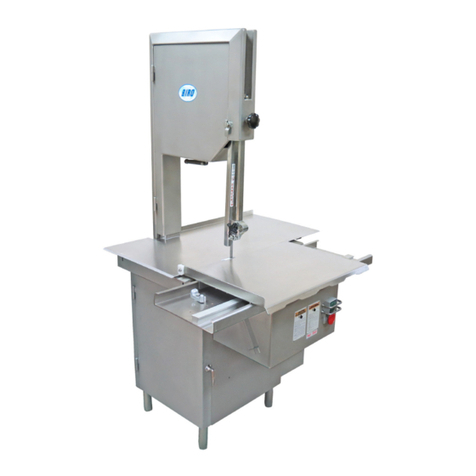
BIRO
BIRO TRUE-LEFT 3334TL Series Operating and service manual
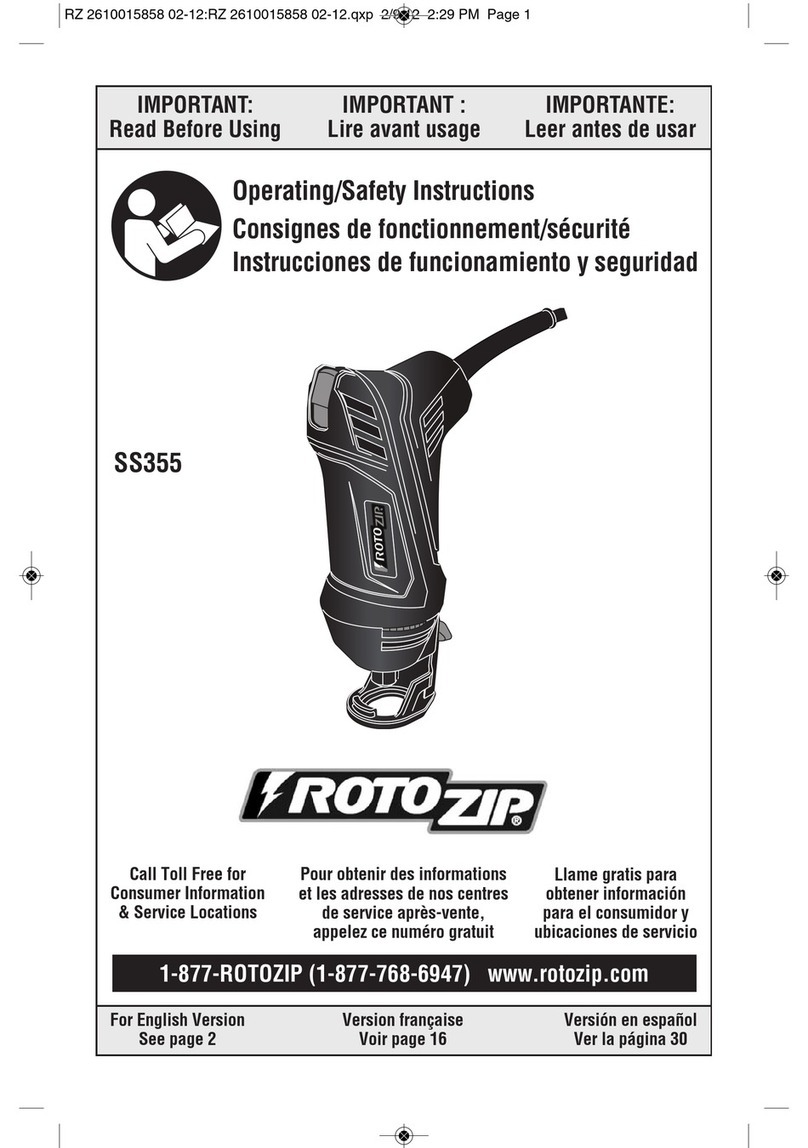
RotoZip
RotoZip SS355 Operating/safety instructions
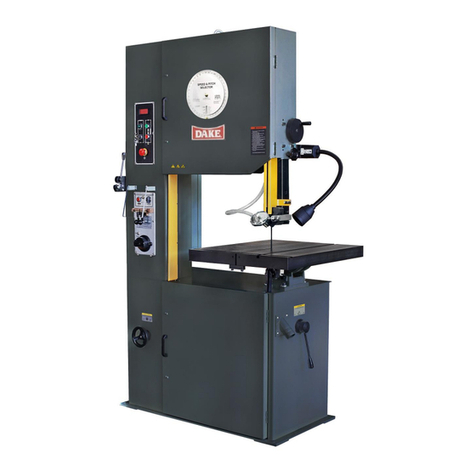
Dake
Dake V-26 E instruction manual
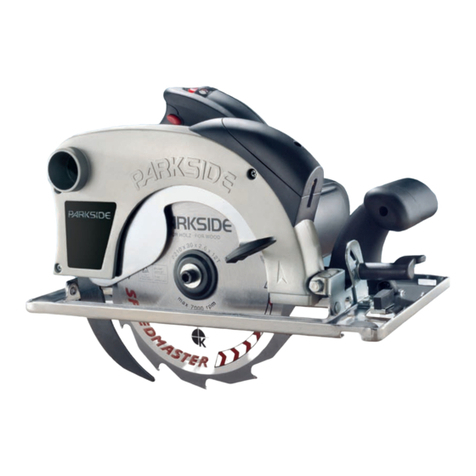
Parkside
Parkside KH 3141 CIRCULAR SAW manual

BN Products
BN Products BNCE-30-24V Operation & instruction manual

Elektra Beckum
Elektra Beckum PK 300 K operating instructions



